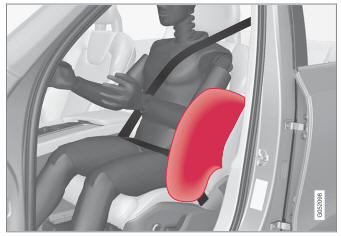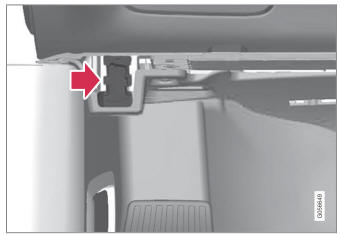Volvo XC90: Safety / Side airbags
The side airbags, on the driver's and passenger sides, protect the chest and hip in a collision.

The side airbags are located in the front seats' outer backrest frames and help protect the driver and front seat passenger.
A collision of a sufficiently violent force will trigger the sensors and one or more side airbags will inflate. The side airbags inflate between the seat occupant and the door panel to help cushion the initial impact of the collision. The airbag deflates when compressed by the collision. The side airbags are normally only deployed on the side of the vehicle impacted by the collision.
WARNING
Volvo recommends contacting an authorized Volvo workshop for repairs. Incorrectly performed repairs to the side airbag system could impair function and lead to serious injury.
WARNING
Do not place any objects in the area between the outer edges of the seats and the door panels, as this could impair the function of the side airbags.
Volvo recommends only using seat covers approved by Volvo. Other seat covers could prevent the side airbags from functioning properly.
WARNING
The side airbag is a supplement to the seat belt. Always wear your seat belt.
 Occupant weight sensor
Occupant weight sensor
The Occupant Weight Sensor (OWS) is designed to meet the regulatory requirements
of Federal Motor Vehicle Safety Standard (FMVSS) 208 and is designed to disable
(will not inflate) the passenger's side front airbag under certain conditions...
 Inflatable curtain
Inflatable curtain
The inflatable curtain, Inflatable Curtain (IC), helps to prevent the driver
and passengers from striking their heads on the inside of the vehicle during a collision...
Other information:
Volvo XC90 2015-2026 Owners Manual: Voice Control
Voice control1 allows you to control functions in the vehicle, e.g. the climate control system, radio or a Bluetooth-connected phone, using spoken commands. In vehicles equipped with Sensus Navigation*, the navigation system can also be controlled using voice commands...
Volvo XC90 2015-2026 Owners Manual: Low Speed Control
The low-speed function (LSC1) facilitates and improves control and traction on rough roads and slippery surfaces, e.g. when towing a trailer on grass or up boat ramps. In vehicles equipped with drive mode control *, the function is included in the Off Road drive mode...

